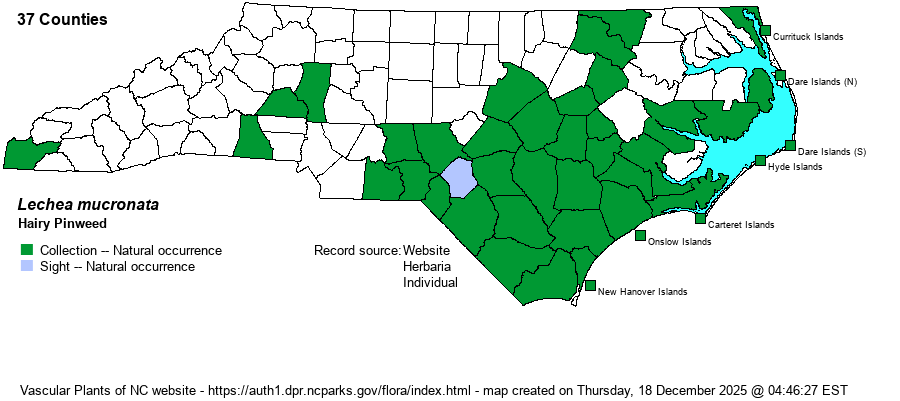| Author | Rafinesque | |
| Distribution | Essentially throughout the Coastal Plain, though of spotty range in the northern portions. Ranges into the southern and far eastern Piedmont, and also known from the southwestern tip of the Mountains (Cherokee County).
This is a widespread Eastern species, yet is essentially absent from the Appalachians and the Piedmont. It ranges from NH west to NE, and south to southern FL and most of TX. | |
| Abundance | Common in the southern half of the Coastal Plain, including the Sandhills. Infrequent to locally numerous in the northern Coastal Plain, but no records yet for many counties. Rare in the far eastern and southern Piedmont and the far southwestern Mountains. | |
| Habitat | This is a species of open and dry habitats, not restricted to sandy soils as are some Lechea species. It grows in dry openings and clearings, weedy fields, pine/scrub oak sandhills, dunes, margins of maritime forests, and dry margins of upland woods. | |
| Phenology | Blooms from June to August, and fruits from July to October. | |
| Identification | This is generally the most robust and tallest of the Lechea species in the state. It often grows to 2 feet tall, rarely to 2.5 feet tall, and is quite villous hairy on the stems and branches. The numerous branches are typically ascending. The long basal shoots usually have whorled leaves, these being ovate to elliptical and rather "large", being about 1/2-inch long. The stem and branch leaves are often whorled, with distinct petioles, narrowly elliptical, and often about 3/4-inch long. This species has the minute flowers densely clustered on short, lateral branches, rather than more scattered as on most other Lechea species. This is probably the most distinct of the genus from other species in NC, as all others have stem pubescence generally appressed, as opposed to strongly spreading. Because of its robust size and height, it is somewhat striking, and its basal shoots are longer than in others as well. | |
| Taxonomic Comments | Most older references named this species as the more correctly descriptive L. villosa.
| |
| Other Common Name(s) | None | |
| State Rank | S4? [S5] | |
| Global Rank | G5 | |
| State Status | | |
| US Status | | |
| USACE-agcp | | |
| USACE-emp | | |

